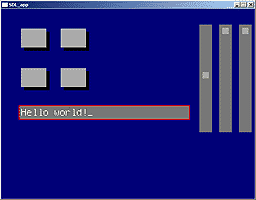Things of recent interest

Here are a few things that have kept my interest lately:
-
Immediate-Mode Graphical User Interfaces Immediate-mode GUI is a straight-forward way of rendering a UI. It’s so simple, in fact, that I had to watch the video twice and do a tutorial to understand it. (I did the tutorial using SDL on OS X, and then ported it to JavaScript and canvas. Incidentally, I also used the C preprocessor on my JavaScript file, following this, to get statically-generated IDs for the widgets, it worked well.) The short explanation of immediate-mode GUI is, in your render() function that’s called for each frame of your application (ala requestAnimationFrame), you call functions that handle everything needed to draw, handle events, change state, and trigger other events, for your UI’s widgets. Your code looks something like
if (button(id, x, y)) buttonWasPressed();, and that’s the entirety of rendering a button widget to the screen and handling click events on it. (In most cases, the widget functions return a boolean of whether the button was pressed, text field was changed, etc.) There are no callbacks or separate bindings. You maintain a tiny bit of global state that helps coordinate all the action. The upside is you have total control over your UI’s appearance and behavior. The downside is, you have to implement all of your UI’s appearance and behavior yourself. My feeling so far is that it is not something you would do if you were just implementing a typical UI in a web browswer, because you have all the browser’s widgets already at your disposal (not to mention HTML and CSS layout). You’d be reinventing the wheel. But it seems an ideal approach for a game UI (which is where I believe the idea originated, in the game development world), on platforms where you don’t already have a core UI or widget library available, in a native mobile application where performance is paramount, or any kind of custom application, even on the web, where you want or need complete over the UI, because, for instance, the supplied browser form elements don’t suffice. For example, immediate-mode GUI would fit something like Soundslice’s custom interface perfectly. (via) -
Functional reactive programming This was an eye-opening talk for me. FRP could show us the way out of the fly bottle of complicated, callback-knotted async JavaScript UIs in the browser. The core idea is to treat events not as isolated occurances to be handled on a per-callback basic, but instead as collections, and once you do that, you have the power of higher-order functions like map, reduce, filter, and merge to describe complex behaviors as sort of a pipeline of collection processing. If you took Python’s list and generator comprehensions to browser events, you start to get the idea. RxJS is the tool highlighted in the talk, but bacon.js also seems to be a popular FRP library for JavaScript (haven’t tried it myself). There’s also a browser-based FRP tutorial to work through.
-
Traceur Programming FRP in JavaScript becomes a lot more pleasant with the new anonymous function syntax (
(x) => x + 1instead offunction(x) { return x + 1; }) coming in JavaScript 6, or ES6. Traceur compiles ES6 to JavaScript that will run in current browsers, so you can code and get the benefit of the new syntax and other upcoming language features now. I have it as a build step in a Makefile, alongside minification. Then presumably, barring language-breaking changes, you’d be able to remove the build step at some future date when ES6 has become widely adopted. -
Elm Elm is an entire language built around FRP which targets the browser. It is a Haskell or OCaml-like language that compiles down to HTML, CSS, and JavaScript. It seems to rely on the functor concept, which it calls ‘lift’, to convert browser events into something its built-in higher-order functions can process. It’s arguable that because it is a functional language like Haskell, it’s more naturally suited for dealing with the sorts of concurrency issues in UIs that libraries like RxJS were created to address in JavaScript. I’m still just in playground mode with it.
-
GopherCon talks It says something about the Go community how uniformly excellent and entertaining these talks are. Interesting and dense with practical knowledge.
I also recently tried to teach myself Acme. You can certainly glimpse the power of a system like that. But ultimately I decided editing speed is more important to me, and I’m pretty fast in Vim, so I abandoned the effort.
CoreOS seems like it could become pretty important.
Programming a computer, still a fun thing to do.